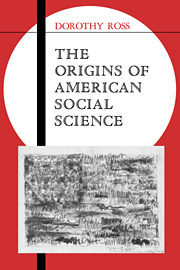Book contents
- Frontmatter
- Contents
- Acknowledgments
- Abbreviations used in the footnotes
- Introduction
- Part I European social science in antebellum America
- Part II The crisis of American exceptionalism, 1865–1896
- Part III Progressive social science, 1896–1914
- 5 The liberal revision of American exceptionalism
- 6 Marginalism and historicism in economics
- 7 Toward a sociology of social control
- 8 From historico-politics to political science
- Part IV American social science as the study of natural process, 1908–1929
- Epilogue
- Bibliographical note
- Indexes
- Ideas in Context
6 - Marginalism and historicism in economics
Published online by Cambridge University Press: 23 September 2009
- Frontmatter
- Contents
- Acknowledgments
- Abbreviations used in the footnotes
- Introduction
- Part I European social science in antebellum America
- Part II The crisis of American exceptionalism, 1865–1896
- Part III Progressive social science, 1896–1914
- 5 The liberal revision of American exceptionalism
- 6 Marginalism and historicism in economics
- 7 Toward a sociology of social control
- 8 From historico-politics to political science
- Part IV American social science as the study of natural process, 1908–1929
- Epilogue
- Bibliographical note
- Indexes
- Ideas in Context
Summary
By the turn of the century, three different economic models emerged from the Gilded Age crisis of American exceptionalism and vied for support in the profession: marginalism, the liberal economic interpretation of history, and the socialist historico-evolutionary economics of Thorstein Veblen. Marginalism, as neoclassical economics, quickly established ascendancy. Veblen's theory was not considered a viable alternative by most of his economic contemporaries, exerting its greatest influence later, through the work of disciples. But the debate over historicism continued on a wide front.
Marginalist ascendancy
The economists who moved economic discourse forward in the Progressive Era were in part the men, born in the 1850s and 1860s, who had already emerged in the Gilded Age as spokesmen in the debate. John Bates Clark at Columbia University continued to work out the implications of marginalist theory. Both E. R. A. Seligman and Frank W. Taussig set out important paths in theory and practice by means of their positions at the major graduate departments of Columbia and Harvard, through their expertise in areas of public policy, and as the authors of popular textbooks. Simon Patten, chair of the Wharton School at the University of Pennsylvania, spoke in an idiosyncratic but revealing voice. Richard T. Ely, grown more conservative, remained a figure of significance largely through his revised 1893 economics text and a band of younger Wisconsin students and colleagues who carried on his reformist impulse.
- Type
- Chapter
- Information
- The Origins of American Social Science , pp. 172 - 218Publisher: Cambridge University PressPrint publication year: 1990

